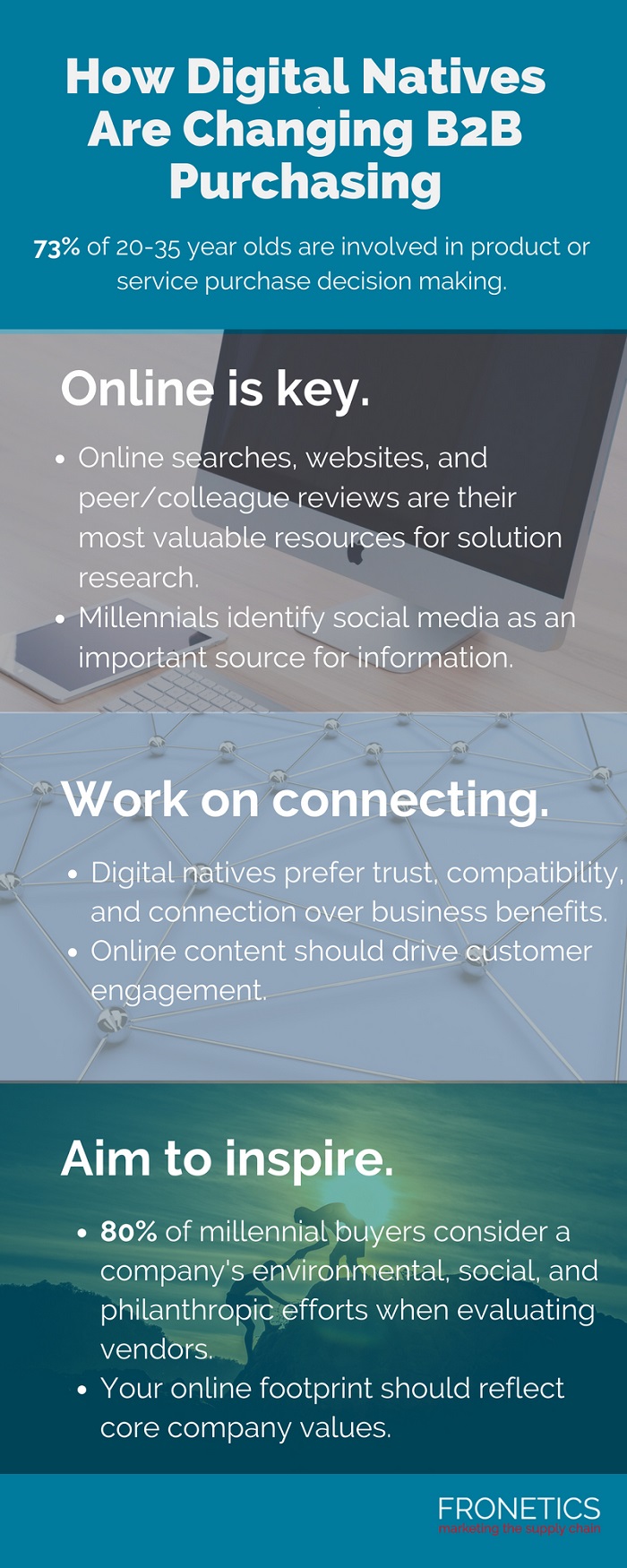
by Fronetics | Sep 12, 2018 | Blog, Content Marketing, Logistics, Marketing, Strategy, Supply Chain
Here are the top three resources digital natives are using to research solutions and how your B2B business can prepare to meet them online.
Knowing where your buyers do research when making purchasing decisions is crucial to any marketing strategy. Digital natives, a new generation of younger buyers, have completely revolutionized the purchasing landscape for B2B vendors. Their biggest resource? The world wide web.
[bctt tweet=”73% of employees ages 20-35 years old are involved in product or service purchase decision-making at their company. In fact, one-third reported they are the sole decision maker for their department.” username=”Fronetics”]
A study of millennial buyers by Merit found that 73% of employees ages 20-35 years old are involved in product or service purchase decision-making at their company. In fact, one-third reported they are the sole decision maker for their department.
What does this mean for B2B marketers?
These younger, and typically more technologically advanced, buyers expect they can find the information they need about your brand online through an organic search. Your company needs to have any and all content available at the push of a button.
But the work doesn’t stop there. Once a buyer finds your brand, you hope they make the leap to visit your website, meaning your site needs to be one of your most appealing assets. If you don’t give visitors plenty of easy, attractive opportunities to convert on your website, content marketing won’t generate leads for you.
But online searches and vendor website aren’t the only resources digital natives are using to make purchasing decisions. This younger generation also relies heavily on recommendations from peers and colleagues.
Like recommendations from friends and family in their personal lives, the opinion of other buyers becomes very important. A big part of the purchasing process involves B2B review sites, where purchasers seek the opinion of their peers and colleagues.
Here’s Elizabeth Hines, creative/editorial director at Fronetics, to discuss the top resources for B2B buyers and how you can be prepared to meet them online.
Video: top 3 resources for B2B buyers
Final thoughts
Though the purchasing landscape has changed over the past decade, B2B marketers have the tools to get in front of the right buyers. These tools including knowing what resources buyers are using and how to use these assets to your advantage. With a documented strategy and high-quality, informative content, you’ll be ready to meet digital natives where they are.
Related posts:


by Fronetics | Sep 11, 2018 | Blog, Content Marketing, Logistics, Marketing, Social Media, Strategy, Supply Chain
Daunted by the idea of proving social media ROI? These 3 steps will give you the structured framework you need to show the results of your efforts.
We all know social media is effective — but do we really know it?
Social Media Examiner’s 2018 Social Media Marketing Industry Report found that only 44% of marketers agree that they know how to measure social media ROI. That means two-thirds of you don’t know whether or not, or how much, your marketing efforts are paying off when it comes to the use of social media.
[bctt tweet=”Only 44% of marketers agree that they know how to measure social media ROI. That means two-thirds of you don’t know whether or not, or how much, your marketing efforts are paying off when it comes to the use of social media.” username=”Fronetics”]
Managing your business’ social media is no small task. It can be a time-consuming and laborious process, so you want to make sure you’re doing it right. That means having a systematic framework in place to prove social media ROI. These three steps will get you started.
3 steps to prove social media ROI
1) Set goals
It may seem obvious, but too many businesses approach social media marketing with vague goals or none at all. Deciding that you want to “grow your business” through social media is great — but it does little to set you up for success.
As you think about goals, keep the SMART principle in mind: Your objectives should be specific, measurable, achievable, realistic, and timed. So for example, instead of shooting to “generate more leads,” set a goal to “generate 10% more leads over 30 days.”
2) Track and measure
Once you’ve set your goals and identified your key metrics, it’s time to implement a system that will track and measure your metrics. At the very least, you should be tracking your metrics on a monthly basis.
We’ve created this monthly marketing reporting template just for supply chain and logistics businesses. It can help you measure social media ROI, as well as track your content marketing efforts, all in one place.
3) React
This is your endgame. While proving your ROI is a great outcome of tracking and measuring your metrics, the real object of your efforts should be reacting to what you discover. Look at your metrics in the context of your goals and objectives. Which efforts are moving you forward? What’s not working?
Trying to prove social media ROI is far from impossible when it’s supported by a solid framework. With a data-driven approach, you can prove ROI and use concrete tools to take steps to improve it.
Related posts:


by Fronetics | Sep 10, 2018 | Blog, Content Marketing, Leadership, Logistics, Marketing, Supply Chain
In today’s rapidly evolving economy, embracing change is crucial for success. These 5 behaviors define supply chain leaders who are change-agile.
They say the only constant in life is change. When it comes to leadership in the supply chain, the old adage certainly rings true.
If the last few decades have been consistent in any regard, it has been in the need to embrace change to keep things running. Agile leadership has been crucial for supply chain and logistics businesses. Are you the kind of leader that truly embraces change?
Why do I need to embrace change?
NextBridge Consulting managing partner Edith Onderick-Harvey identifies 5 behaviors that are common among agile leaders. Onderick-Harvey points to an inability to embrace change as a key cause of failure in business — making the idea of “change-agile” leadership a crucial part of a business and a leader’s DNA.
[bctt tweet=”Being a successful leader depends on embracing change by “seizing opportunities, including throwing out old models and developing new ways of doing business,” writes Onderick-Harvey.” username=”Fronetics”]
Change isn’t easy in any area of life, and corporate leadership is no exception. However, being a successful leader depends on embracing change by “seizing opportunities, including throwing out old models and developing new ways of doing business,” writes Onderick-Harvey. She stresses the importance of inculcating a culture of “change thinking… from the most fundamental daily interactions to the most complex strategy.”
What defines a change-agile leader?
Onderick-Harvey identifies these five behaviors that are characteristic of change-agile leaders:
1. They share a compelling, clear purpose.
Embracing change just for the sake of isn’t enough. “If you can’t articulate a clear purpose behind the changes being made,” says Onderick-Harvey, “it’s unlikely that your employees will be able to implement them.”
2. They look ahead and see opportunity.
It’s not just senior executives who should be looking toward future opportunities. A culture of change-agility should pervade every level of the corporate structure. “Look beyond this month or this year to identify trends and take action.”
3. They seek out what’s not working.
Being a change-agile leader goes beyond simply being receptive to unsuccessful projects — it’s about encouraging communication and actively seeking out what isn’t working at any level of your business. “For real learning to occur,” writes Onderick-Harvey, “people need to feel psychologically safe to share the good, the bad, and the ugly.”
4. They promote calculated risk-taking and experimentation.
We all know that risk and experimentation are crucial for growth, but many of us are too reticent to boldly embrace these concepts. It’s not easy to remember that failure is an important step on the way to success. “Change agility requires leaders to ask ‘Why not?’ and to establish opportunities for pilots, prototypes, and experimentation.”
5. They look for boundary-spanning partnerships.
As the world grows ever more interconnected and work becomes more complex, success is increasingly dependent on seeking out collaboration across boundaries. “Change-agile leaders and organizations are replacing functional silos with formal and informal organizations that allow for the rapid flow of information and decision-making around a product, customer, or region.”
Welcoming and embracing change is good for every aspect of your business’ health. Do these behaviors sound like you? What can you do to promote change-agility in your business’ culture?
Related posts:


by Fronetics | Sep 6, 2018 | Blog, Content Marketing, Current Events, Logistics, Marketing, Social Media, Strategy, Supply Chain
Digital natives are changing the landscape for B2B purchasing. Here’s what you need to know about the new B2B buyer.
Long gone are the days of men and women sitting around a conference table listening to a sales pitch over a free lunch. Today’s B2B buyers are younger, more technologically savvy, and more independent — they’re a generation of digital natives. And they’re making waves across the B2B buying landscape and changing how marketers must work to reach new customers.
[bctt tweet=”Today’s B2B buyers are younger, more technologically savvy, and more independent — they’re a generation of digital natives. And they’re making waves across the B2B buying landscape and changing how marketers must work to reach new customers.” username=”Fronetics”]
Who are digital natives?
The term digital native describes a person that grows up in the digital age, rather than acquiring familiarity with digital systems as an adult. So, unlike the previous generation, digital natives grew up understanding how to work a computer and a mobile phone instead of picking up these skills (slowly) in our 20s, 30s, or even later.
Having grown up in a time of rapid technological advancement, digital natives are very comfortable online. These skills have carried over to their professional careers, as millennials descend upon the workforce. Organic searches have become the starting point for researching products and services, instead of looking for specific brands.
Ch-ch-changes
This new reality means marketers trying to reach new customers must make big changes in the way they target and engage today’s buyers. Marketers have had to shift their focus from outbound marketing to inbound tactics, like content marketing, to engage and connect with their target audiences.
Here’s what you need to know about digital natives and how their tech-savvy ways have changed the B2B purchasing process.
Infographic: How digital natives are changing B2B purchasing

(Made with Canva)
Final thoughts
With so much content available on the internet, first impressions are everything. Your website needs to be informative and visually pleasing. Your social media posts need to be engaging. Your blog posts need to be enlightening. Make sure your online presence accurately depicts who you are as a brand and what you stand for. Digital natives will be more likely to find and connect with you.
Have digital natives had an impact on your business? Tell us about it.
Related posts:


by Fronetics | Sep 5, 2018 | Blog, Content Marketing, Logistics, Marketing, Strategy, Supply Chain
When your content marketing and sales forces align their efforts, they form a powerful symbiotic relationship that grows your brand and your bottom line.
There’s a big misperception out there that content marketing represents some kind of threat to the job security of sales personnel. It’s absolutely true that content marketing is an inbound approach, contrary to the traditional outbound approach of a B2B sales force. But make no mistake: Content marketing is not a substitute or replacement for an expert sales staff.
[bctt tweet=” It’s absolutely true that content marketing is an inbound approach, contrary to the traditional outbound approach of a B2B sales force. But make no mistake: Content marketing is not a substitute or replacement for an expert sales staff.” username=”Fronetics”]
In fact, it’s when marketing and sales work in tandem that they’re most effective. They can help each other out to generate more leads, nurture current leads more effectively, and even help close more deals.
Content marketing helps generate a steady flow of quality leads, and it provides targeted information to usher prospects down the sales funnel. But even quality leads don’t turn into sales on their own. This is where a sales staff comes in, to take those leads and cultivate them into new business.
Content marketing and sales: Division of labor
For content marketing and sales to work seamlessly together, it’s important to have a clear idea of the role of each. They provide different touch points for leads at each stage of the buying cycle. Here’s a quick primer:
1. Forming a relationship
In this early stage of the buying cycle, your content marketing efforts go toward opening up a dialogue with potential customers. Often, potential leads’ first engagement with your brand comes when they read one of your blog posts, come across your website while searching for product solutions, or see one of your social media posts through their network.
This is when your sales staff picks up the ball, keeping that positive contact going by developing it into a conversation. It’s your sales team’s job to cultivate an ongoing personal relationship with that prospect.
2. Providing information
Now that you’ve established a relationship and your sales team is continuing a dialogue with your prospect, content marketing can step in. B2B buyers report spending more time than ever conducting research, using expert content such as vendor websites, user reviews, and social media before making purchasing decisions. The content that you share with prospects at this stage of the buyer’s journey should be designed to answer informed questions and tip the scales in your favor.
At this stage, your sales staff should be directly answering questions from prospects. When a potential customer reaches out with a query, it’s likely that he or she has done a fair amount of research. So your sales reps need to speak specifically to the customer’s needs in a way that content alone can’t do, to keep them interested and moving down the funnel.
3. Advocating for your brand
Content marketing increases brand awareness for your business. It helps elevate your brand position within the industry and keeps your business top-of-mind, even at a time when potential customers aren’t ready to make a purchase.
When a customer is preparing to make a purchase, your sales staff is the primary advocate for your brand. They should be proactive in pursuing business when customers show interest in your content or when they reach out with questions. They drive dialogue and get to know customers and how your business can help them.
A match made in heaven
When content marketing and sales work together, you’ll see the results hit your bottom line. Curating and creating great content will generate quality leads for your company. And it also empowers your sales force to build relationships with potential customers — and close the sale.
Related posts:


by Fronetics | Sep 4, 2018 | Blog, Content Marketing, Logistics, Marketing, Social Media, Supply Chain
Live video is a powerful tool that can help your supply chain business grow its social media footprint, build brand awareness, and generate leads.
Live video is the super-hot new thing when it comes to generating leads and selling. But the supply chain has, so far, been hesitant to embrace it whole-heartedly as a marketing tool.
I can understand how you might find this new content format too “young” or consumer-facing for B2B sales. But at Fronetics, we think if done right, live video can be really effective.
What is live video?
Maybe you’ve gotten a notification on Facebook to let you know that your nephew is live streaming his piano recital, or a college friend is “live” at a wedding. But, let’s face it: Not many supply chain companies are using live video in their social media marketing. So you may not have thought about it in a professional context.
This “it’ trend in social media has really taken off in the past two years, and marketers are starting to jump on the bandwagon. With today’s emphasis on corporate transparency and putting a real, human face behind business social media accounts, live video is a perfect fit. In fact according to the 2017 Social Media Marketing Industry Report, 61% of marketers plan on using live video services, and 69% are interested in learning more about it.
[bctt tweet=”61% of marketers plan on using live video services, and 69% are interested in learning more about it, according to the 2017 Social Media Marketing Industry Report.” username=”Fronetics”]
These are the 4 live video platforms you should be aware of.
1. Facebook Live
Facebook’s live streaming platform lets you broadcast for up to 90 minutes per session, and notifies your audience that you’re streaming live. It also allows viewers to comment and react during your broadcast, and you can read and respond to their remarks immediately.
2. Periscope
Twitter’s answer to live video, Periscope has more than 10 million users, and lets user live stream from their mobile devices and push those streams directly onto Twitter.
3. Instagram Live
Instagram lets users connect to their followers in real time, through its Stories feature. Like Facebook, Instagram lets viewers add real-time comments that are visible to you and the rest of your audience.
4. YouTube Live
Online streaming video juggernaut YouTube makes it incredibly easy to aim, shoot, and post live video.
How to use live video
Michael Stelzner of Social Media Examiner recently interviewed income strategist and Facebook Live-guru Nicole Walters on the Social Media Marketing Podcast. Walters gave listeners clever tips for using live video to build a following and generate leads. We recommend giving the podcast a listen, but read on for our key takeaways.
Walters advocates for spontaneity in live video but suggests having a format or framework to give you structure and ensure that you’re sticking to your goal of generating leads. Her format is in three parts:
Part One: The Opener
In your introduction, which should be about 30-45 seconds, Walters suggests starting with your name, website, and a brief sentence to give your audience an overview of who your business is and what your video is about. Next, be sure to welcome your audience, perhaps with a special shout-out to new viewers, as well as regulars. Walters also encourages viewers to share her video and to interact with her as she broadcasts.
Part Two: Instructional Content
This is the meat of your video and typically lasts up to 30 minutes. Start by introducing the topic you’re presenting on and why it’s important. Walters also suggests encouraging viewers to take notes, with the rationale that notetaking leads to engaged viewers. If you’re launching a product or service (a great use of live video), you’ll want to cover the need you’re answering with your launch and how your product or service will solve it.
Walters points out that while she prepares extensively for her broadcasts, she avoids reading directly from a piece of paper, as it could easily get impersonal and boring. Instead, she gives herself a cheat-sheet of bullet points to keep her on track.
Part Three: Call-to-Action
This is the final stage of your live video, in which you send your viewers to a page where they can either pay or submit information to receive additional, high-value content (like e-books, webinars, etc.). Walters might say, “If you love this and want to dive in and get the details you need, then head over to NicoleWalters.tv. If you click the center of the page, you’ll find the product… I’ll be right here if you have questions. But come back and tell me you grabbed it.”
Live video offers all kinds of potential value for supply chain marketing. From customer engagement and feedback to transparency and brand awareness, this is a tool for the future of supply chain marketing.
Related posts:













